Shunka Warak’in Taxidermy Specimen Found!
Posted by: Loren Coleman on November 15th, 2007
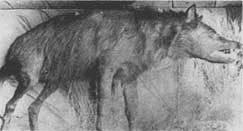
Above is the photograph which has become familiar from my book, Cryptozoology A to Z (1999), and then lifted from there to be shared throughout the internet. The story of the 19th century shooting and mounting of this unknown cryptid canine has been repeated often. It is scheduled to be one of the stories discussed in a forthcoming History Channel “Monster Quest” program. The “Monster Quest” film crew visited the International Cryptozoology Museum specifically to talk to me about this cryptid and other related canine enigmas.
The mystery of the Shunka Warak’in has been an enduring one in cryptozoology. It appears today that we may be closer to solving it. This is a remarkable turn of events, and I could not be happier to hear about this.
I look forward to thoughtful individuals considering the DNA testing of the newly re-discovered taxidermy mount. Intriguingly, if it is still owned by the the Idaho Museum of Natural History in Pocatello, perhaps now Dr. Jeff Meldrum could request the test. Dr. Irv Kornfield’s University of Maine DNA lab is ready and willing to do this testing. – Loren
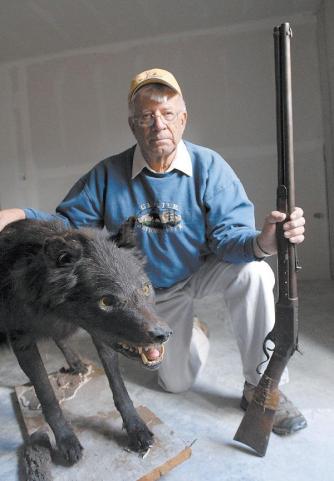
Jack Kirby poses in Ennis next to the wolf-like creature his grandfather shot in 1886 in the Madison Valley. He is holding the G.W. Morse rifle that was used to kill the animal. Kirby retrieved the mount from an Idaho museum where it was being stored. Photo by Deirdre Eitel/Chronicle.
Ennis – More than a century ago, a wolf-like creature prowled the Madison Valley, killing livestock and letting out screams that one account said would leave a person’s hair standing on end.
A bullet from a Mormon settler’s rifle ended the animal’s life and triggered stories of the creature that were passed along through generations of family history and local folklore.
The only evidence of the creature’s existence was a missing taxidermy mount and a grainy black-and-white photograph of that mount – which fueled strange speculation about what kind of animal it really was.
Now after 121 years, the taxidermy mount has been found. The creature that once spooked some of the Madison Valley’s first white settlers has come home.
“I never doubted the story,” said Jack Kirby, grandson of the settler who shot the animal.
After reading a Halloween-themed Chronicle story about local legends of strange creatures, Kirby tracked down the mount in the Idaho Museum of Natural History in Pocatello.
The museum has since loaned it to him to put on display at the Madison Valley History Museum, although at the moment it resides in the basement of a building on the north edge of town.
The “ringdocus” or “shunka warak’in” – two of the names it has been given over the years – strongly resembles a wolf, but sports a hyena-like sloping back and an odd-shaped head with a narrow snout. Its coat is dark-brown, almost black, with lighter tan areas and a faint impression of stripes on its side.
It measure 48 inches from the tip of its snout to its rump, not including the tail, and stands from 27 to 28 inches high at the shoulder.
The mount is in amazingly good shape, showing no signs of wear and tear and retaining the color of the fur. It arrived in Ennis Friday.
One of its first stops was the gravesite of the man who shot it, Israel Ammon (I.A.) Hutchins.
“We took him down to the cemetery to see I.A. to let him know (the creature) is back in the valley,” said Kirby’s wife, Barbara.
Hutchins shot the animal in 1886 on what is now the Sun Ranch, but not on his first try. He accidentally shot and killed one of his cows when he first spotted the creature on his land, his son Elliott Hutchins recounted in his memoirs.
He killed the strange animal when it appeared on his land a second time and traded the body with entrepreneur Joseph Sherwood for a new cow.
Sherwood was a taxidermist. He mounted the animal and put it on display in his combination store-museum at Henry’s Lake in Idaho. His taxidermy collection was later given to the Idaho Museum of Natural History, where it was kept in storage.
The creature apparently baffled the people who saw it alive, and some speculated it was a hyena escaped from a circus rather than a wolf. The younger Hutchins remembered its haunting screams at night and wrote that after it was shot and in its death throes, the animal bit through a half-inch rope with a single bite and “exerted his very last strength to reach any one of us.”
The story of the “ringdocus” – as Sherwood reportedly named it – reached a national audience when the prolific writer and naturalist Ross Hutchins wrote about it in his 1977 autobiography, “Trails to Nature’s Mysteries: The Life of a Working Naturalist,” and included a picture of the mount. I.A. Hutchins was his grandfather.
The tale was again picked up by writers Loren Coleman and Jerome Clark in their book “Cryptozoology A to Z.” In that book, Coleman linked it to a Native American legend about the “shunka warak’in,” a creature that snuck into camps at night to steal dogs.
The animal has so far eluded identification. The younger Hutchins wrote that a detailed description was sent to the Smithsonian Institution, which wasn’t able to identify it.
The picture of the mount included the scientific-sounding name “Guyasticutus” as a label for the creature, but the name may have been tongue-in-cheek. Early accounts report that the Guyasticutus was a mythical creature invented by traveling showmen to swindle gullible ticket-buyers.
Coleman and Clark suggested that a DNA test should be done on the mount to determine what it is. Kirby, however, was not so certain he was ready to end a mystery that had been passed down by his family for four generations.
“Do we want to know?” he said.
The mount will be displayed in the Madison Valley History Museum when it reopens in May.“Mystery monster returns home after 121 years,” by Walt Williams, Chronicle Staff Writer, Bozeman Daily Chronicle, Bozeman, Montana.
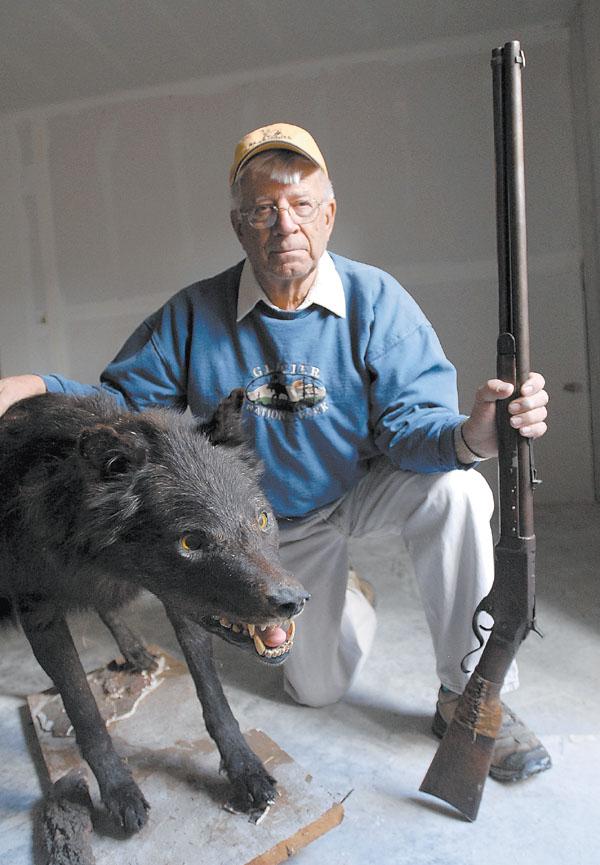

About Loren Coleman
Loren Coleman is one of the world’s leading cryptozoologists, some say “the” leading living cryptozoologist. Certainly, he is acknowledged as the current living American researcher and writer who has most popularized cryptozoology in the late 20th and early 21st centuries.
Starting his fieldwork and investigations in 1960, after traveling and trekking extensively in pursuit of cryptozoological mysteries, Coleman began writing to share his experiences in 1969. An honorary member of Ivan T. Sanderson’s Society for the Investigation of the Unexplained in the 1970s, Coleman has been bestowed with similar honorary memberships of the North Idaho College Cryptozoology Club in 1983, and in subsequent years, that of the British Columbia Scientific Cryptozoology Club, CryptoSafari International, and other international organizations. He was also a Life Member and Benefactor of the International Society of Cryptozoology (now-defunct).
Loren Coleman’s daily blog, as a member of the Cryptomundo Team, served as an ongoing avenue of communication for the ever-growing body of cryptozoo news from 2005 through 2013. He returned as an infrequent contributor beginning Halloween week of 2015.
Coleman is the founder in 2003, and current director of the International Cryptozoology Museum in Portland, Maine.






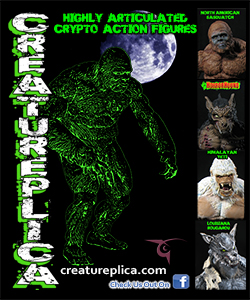
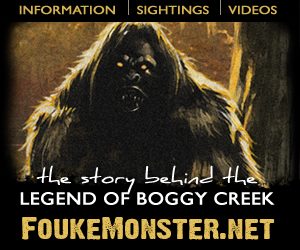
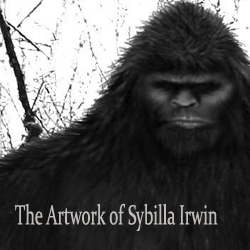

It looks like a wolf. Note the teeth.
No matter what it “looks like,” if a good sample can be obtained (and usually with a mount they can), certainly DNA testing could determine what it is.
Incredible find!!!
By the way Loren, too bad the funds are not likely avaliable to add this guy to your museum, gaff or not.
It’s good to have something that can be tested. I have to agree, though, it looks a lot like an ordinary wolf. Maybe it had hip deformities like some domestic dogs.
Interesting rediscovery! Does anyone know about the taxidermy methods used in the 1880’s? Did they use the actual skeletons, or did they cover artificial frames, like many do today? In other words, are those the real teeth and shape of the head? If Sherwood was a sensationalist, he could have manipulated the framework to look less wolf-like.
I hope the DNA testing is approved and yields good results!
showme: I had the exact same thoughts regarding the manipulation of the specimen. There’s actually a great representation of this practice in a film called ‘Brotherhood of the Wolf’ from a few years ago that shows taxidermists in late 1700s France manipulating a regular wolf to look like a massive, scary werewolf-type creature.
Showme
Some or all of the skeleton could be under the skin. Smaller mammals were rearticulated and covered in clay or wood wool was wrapped around forming the muscle structure. If the taxidermist was not very talented the underlying form could be misshapen.
The skull is almost certainly original and they can hopefully extract DNA from a tooth.
Caution should be taken by anyone handling these old mounts. Gloves and a respirator are recommended due to the arsenic used to tan hides back then.
Thanks, Huntress!
I hope the chemicals used in the process won’t taint any DNA.
very interesting !
I’m waiting for DNA results !
The body suggests hyena, but judging by the head it’s obviously some kind of canine. Contrary to popular belief, hyenas are not canines at all, but classified in their own family. The head on this thing definitely is more wolf-like. Whatever the DNA results show, it will be some species of Canis.
How long would it take, could it be a new species or a Hybrid, a Coy-Dog?
The head is definitely canine. I have no doubt about that at all. The body is unusual, though. Looking at the new photo, I’d say there is nothing too out of place for a wolf, but the older photo is different, giving us a full body side view. The morphology seems curious, and I don’t think I can say with any certainty that it is a wolf. It could be a unique subspecies of wolf or a hybrid of some sort, I suppose. I would be very interested to see what the DNA test results turn up.
The exciting thing for me about this story is the way it shows that old accounts can hold some validity. There seem to be a lot of stories in the annals of cryptozoology concerning evidence that has gone missing as well grainy old photographs being all we have left. Hearing the story about the mysterious, screaming, cow killing beast and how it was shot but the mount went missing, it is easy to write it off as just an old tale or folklore. This new development just goes to show that sometimes there may actually be something to the stories.
Oh yeah, and thanks Huntress for the taxidermy information. I also wonder the skill with which these animals were mounted in those days and if it could have contributed to the odd looking body we see in the photo.
This is really interesting!!!!!!!
But back on my current hobby horse, DNA from hair, following on recent developments.
This could be a golden opportunity to put the method to the test! Good DNA has recently been successfully extracted from a 200 year old museum specimen. Using hair would avoid damaging the mount and could give a better result, at least with mitocondrial DNA.
My guess is the DNA will be canid (I hope not) and probably wrongly, not considered special. DNA science is still relatively new and has a long way to go. I have the advantage of not being an expert and think if an animal appears to be very different it probably is and if DNA seems to say it is not, then the DNA, as it is currently understood, should not be taken as the absolute answer (Not forgetting dear Oliver).
Thank you Loren for letting us know about this discovery. Can’t wait for the story to unfold!
Looks more like a wolf in that photo.
Great find Loren!! Now, let’s see if we can track down the Minnesota Ice-man!! By the way, this wolf-thing should be in your museum , after all it is kind of crytptic isn’t it??
Yes, of course, I would be delighted to have the Shunka Warak’in mount in the International Cryptozoology Museum, but I sincerely doubt if the Idaho Museum of Natural History is going to dispose of it easily now, especially after all the publicity and realizing in the wake of today’s media how important a taxidermy object it is.
I would expect that the visitors to the Madison Valley History Museum, Montana, will experience a jump in numbers when this mount goes on exhibit in May. And I bet that when it is returned to the Idaho museum, they take it out of storage, and put it on permanent exhibition – as it should be, for educational reasons!
Yes, yes, anything cryptozoological would be appreciated for the International Cryptozoology Museum or donations too – paypal lcoleman@maine.rr.com – so I can purchase exhibits and display cabinets!!
If I learned this mount was looking for a home, of course, I would be first in line. But I appreciate that something as valuable as this object will now, finally, be cherished by those that own it, as it should be.
Kinda looks like a wolf’s head on a hyena body to me. Very strange looking animal no doubt. Let the test begin!
Well, if it can be done, by all means I really hope they can do a proper DNA test on this thing.
Although my money is that it is a wolf 😉
Question: Do wolves suffer from hip dysplasia, like some dog breeds (e.g. german shepherd)?
quite the conundrum. the head looks like a wolf, the body that of a hyena…hmmm. Maybe a waheela relative?
This is a very nice surprise-I’d echo Mystery Man’s comment about this discovery lending much more weight to old reports. Its been awhile since I read the account of the Shunka Warak’in, and I think I may be confusing it with another canid cryptid of the southwest-it wasn’t supposed to be poisonous, was it?
In any case, I can now hope some of the ten and twelve foot tall hominid skeletons that were turning up all over the place might yet be re-discovered…
Look at the body, it reminds me of a hyena.
Very interesting opportunity to have actual DNA to check against our speculations. I patiently await the results.
This old taxidermy is very interesting. I highly recommend Carl Akeley’s enjoyable biography “In Brightest Africa” if your interested in the genesis of realistic, and at times, artistic taxidermy.
While I agree that it’s probably a wolf, it does bring to mind early reports from the west of sub-populations of wolves with adaptations that made them particularly well suited to following the large herds of bison, giving them a more mastif conformation ideal for their strategy of “doggedly” pursuing the prey and latching on. I think by the time modern biologist arrived to take a scientific survey of the wildlife inventory, it had alread been depleted of a number of species and unique populations. Even the wilderness landscapes that we see today is are not the landscapes that have typified the continent for most of its holocene history, neither in its fauna nor its flora. Think about it; just the extinction of bison and chestnut alone have left the continent depleted of two of its major keystone species and major contributors to the native character of the ecosystems in which they were at one time beyond abundant.
Another aspect of animal curiosities that I believe I read about here was the example of what appeared to be a grayhound or whippet of some breed that possessed a rare variant of some genetic trait that produced in the animal the quivalent of twice the muscle mass. Could this genetic rarity occasionally make its appearance in the ancestors of our dogs?
Dogu4- You are very right about the effect that the disappearance of one species can have on the ecosystem as a whole. A keystone species will have a top down effect on many other animals within a given habitat. Startling changes in the ecosystem can be seen when a species within it goes extinct or a new one is suddenly introduced.
I have no doubt that there could be a genetic variant such as you mentioned in a dog. Domesticated dogs as you are probably well aware, are basically shaped through artificial selection and selective breeding and we end up with such varied appearances as chihuahuas all the way up to mastiffs. I would not be surprised at all for a whippet like dogs to exhibit such traits. Dogs in general have a vast variety of variations in appearance, so curiosities like that are bound to pop up.
While we are on the topic, I think it is important for people to realize that Canines are one of the most biologically diverse groups of animals on the planet. They have found ways to adapt and survive in a myriad of different ecosystems, from the deserts to the arctic. They have shown time and time again to be highly adaptable, and it is interesting to look at the amazing changes in morphology taken on by canines in this respect.
You get animals like the maned wolf, which has evolved to have long, stilt like legs useful for seeing over tall grasses in its grassland habitat. Then you have the arctic fox, which has adapted to survive year round in a cold and harsh environment, with its thick coat of fur (which even covers the pads of the feet!) and small ears that are useful for preventing heat loss. Then you have canines adapted to thick forest, with smaller sizes and shorter legs for getting through underbrush, like the gray fox and extinct Honshu wolf. Among canines, you have specialists, which are highly selective about habitat and food, and gregarious generalists like the coyote which can live in many different environments. This is just a small sampling of the amount of diversity that can be seen. Dogu 4’s mention of the canine specialized to hunting bison fits well into the established adaptability and variation of canines.
More speculation here, but one extinct animal that sprung to mind when I heard about the Shunka Warak’in is the Borophagines. This was a group of canines that lived from the middle Ogigocene up to the Pliocene and suceeded the smaller Hesperocyoniae. These animals filled an ecological niche similar to hyenas today and had similar powerful, bone crushing jaws. Their general appearance and morphology was also reminiscent of hyenas. They were a very successful group, in total comprising 66 species and at their peak made up about 16 at one time, which is very diverse even by canine standards. they died out around 2.5 million years ago, but it is still the creature I think about most during all of this talk of hyena-like canines.
How often does a mystery like this one resolve itself? What were the odds of this mount being rediscovered 121 years later, and in good condition to boot? I eagerly await the results from the DNA testing.
A lot of commenters have pointed out the similarities between the photographed creature and hyenas. The animal that really seems to fit with this, and which I offer for your consideration, is the Borophagines. This is an extinct group of hyena-like canines that fit into a similar ecological niche as modern hyenas and shared similar physical characteristics, such as a proportionately large head and bone crushing jaws. I imagine they looked a lot like the hyenas of today. They lived in North America and were quite successful, showing a good deal of continental diversity. At one point, there were 16 different species of them in North America, which is incredible even when compared to the diverse canines of today. Presently, the most species of canines found on any one continent I believe is 11. This group of animals died out around 2.5 million years ago, so this is all speculation of course, but it still is the animal that most springs to mind during this discussion.
Doesn’t even look like the same animal to me. The older picture looks like a wolf head on a pig-like body. The picture with the man and his gun looks like a regular black wolf and I am very sure that there is a reason they carefully cropped or composed the picture to NOT show the entire body, because it really doesn’t look like the older picture. I say take a new picture from the same angle.
Looks like a bad taxidermy job on a brown hyena (not a spotted hyena) take a look at these pictures, I have been looking at this for 2 days wondering and looking for decent pictures of the brown hyena, one is very similar to the taxidermy model. http://home19.inet.tele.dk/hyena/brown_hyena_photo.htm
They are also known in Namibia as the strand wolf (beach wolf) where they usually scavange seal, whale and and other sea creature carcasses. They are well known in South Africa to but usually do not hunt, they may take a small lamb or calf occasionally but generally don’t. They can be quiet smelly and are very shy. http://www.strandwolf.org.za/home.htm. Best time to find one is under spot lights at night, they are solitary animals and far less known than the spotted hyena and are not so noisy.
Now THIS is exciting news. The possibility that a cryptozoological mystery may have a definitive solution is cool. The solution may enhance the field, or remove the mystery. Very cool, either way.
So…the demise of the borophaginea line 2.5 mya. Thanks for that info Mystery Man. Amazing that it could go from such prolific success to extinction in all of its 66 different recognized populations (so far) in such short time…if in fact it did. With the discovery of mammoth bones on Wrangel Island dated to only a few thousand years ago, it’s tantalizing to think about how much longer these borophaginae might have hung-on in out-of-the-way refugia and other unexpected niches. Fossils being so rare and so few of those which have been created having been found and correctly identified, it gives would-be paleocreature enthusiasts hope that new and amazing creatures are still out there…way out there.
It would be great to have a pet like that…studded collar, heavy chain leash…I’d name her “Chompers”.
Dogu4- “Chompers” it is. 🙂 By the way, sorry about repeating the stuff about Borophaginae over two posts. I wanted to clarify some points, namely that it was 66 species total within the North American continent, and I ended up just rehashing the last part of my fist post so as not to confuse people and make them have to go looking for what I was talking about. In case you were wondering what I was on about, that’s the reason.
Mysery Man…thanks for makin’ that clear. You’ve no doubt heard the toastmaster’s triple admonition to “tell me what you’re gonna tell me, then tell me what you said you were going to tell me, then tell me what you just said.”
That is impressive diversity for a group of species, making it all the harder to believe that all of those experiments failed so momentously.
Of course coming from a time when fully one quarter of all mammal species are bats, one has to ask if there is some kind of practical mathematical constant one could apply to the number of known species in the fossil record that would result in the probable number of actual species, presuming that we’ve located and identified only a portion of the species (recognizing that the way we use species in the context of the paleo record is different from modern population based criteria).
For that matter, how many species of primates have there been here on t”he planet with all the apes” across our evolutionary parade ground.
I agree this an exciting find. I don’t know enough about animal behavior to determine what it is but I agree with mystery_man it looks like some sort of hyena offshoot.
Dogu4- The diversity of Borophaginae is made even more impressive when one considers that this was only one of the three subfamilies of Canidae. Likely this group of animals was fairly diverse even within this subfamily, with each species adapted to different habitats and lifestyles. You would have had your scavengers as well as your pack hunters. This all makes it interesting that such a seemingly successful group of animals died out like that. I always enjoy discussions on what it was exactly that drove a given species or group of animals to extinction, especially in the case of an obviously well established one like Borophaginae.
Primates, now that you mentioned it, are themselves an enormously successful group of animals. Like Canidae, they have adapted to a mindboggling variety of climates and ecosystems.
Don’t want to get too off topic with bats, but they are an interesting story in their own right. Guess we’ll save that one for another thread. 🙂
I am glad I found this website. I would like to know the results of the DNA test. I saw that show on the History Channel about crypto-canines and it showed the pic of the Shunka Warak’in. The reason I am interested is I saw something similar to this near Glenn Ullin North Dakota, right off I-94. I told my wife about it, and wrote it off as a weird looking dog. However, the characteristics of what I saw resembled a hyena-like dog. It surely wasn’t a wolf. I lived in Alaska and Eastern Idaho and have seen wolf in the wild and know what they look like. Also, the animal I saw seemed to have a short snout, nothing like a wolf or coyote. It had a very powerful build and a funny gate as it strutted off down a creek wash. I didn’t observe it long, ( I slowed down as much as possible). I saw the animal about 8am, it walked off the road and down a creek wash. I hope to see it again and maybe take a picture. I am not saying I saw anything special, however I have never seen a dog, wolf or coyote look anything like this thing. It truly was unique, whatever it was.
Very interesting. I sincerely hope the owner will allow a DNA test. Sure, mysteries are nice, but they teach us nothing. Answers further the knowledge of the human race and can lead to surprising breakthroughs. Plus, for those who like mysteries, answers usually bring up NEW mysteries!
No matter what the DNA findings show, Kirby and his grandfather will remain a part of cryptozoological (and taxedermilogical) history. They have nothing to lose.
On first glance I was sure it was a wolf with a bad (or fanciful) mounting job. However, one thing bothers me… Wolves generally have long hair on their haunches under the tail, and this fellow’s haunches appear bare. You can clearly see the angulation of the backside of the hind limbs. Thoughts?
I know for a fact that the previous Mammology Curator and the current Paleontology Curator at IMNH have both examined this animal and stated that this is a poorly mounted black wolf, period.